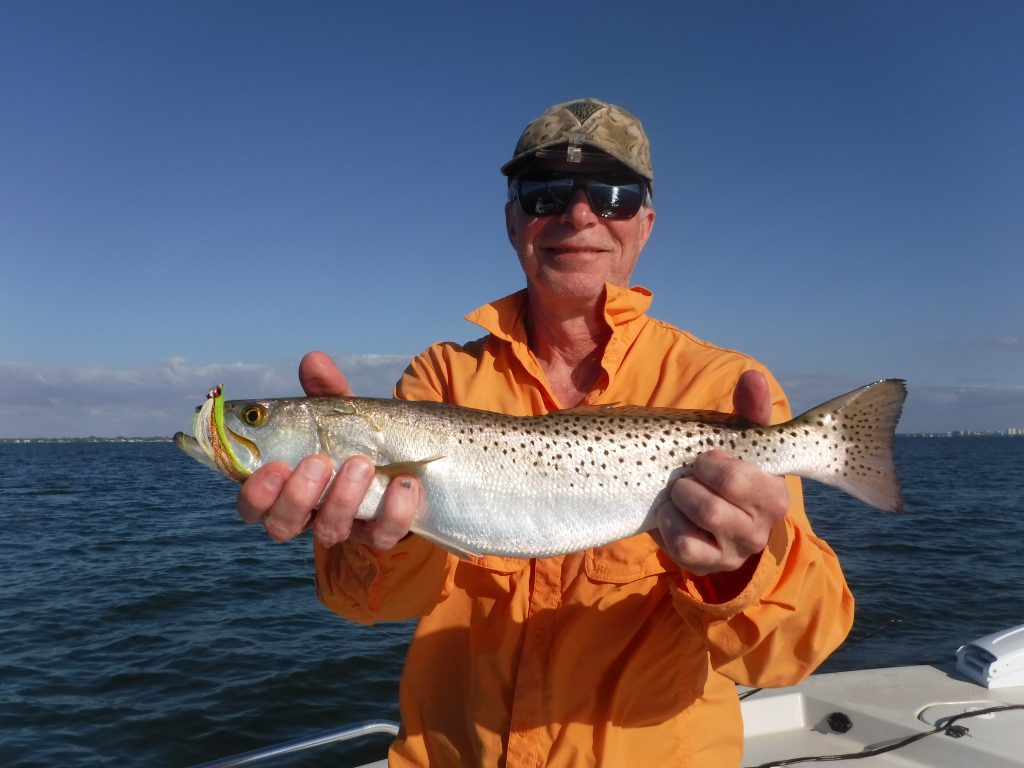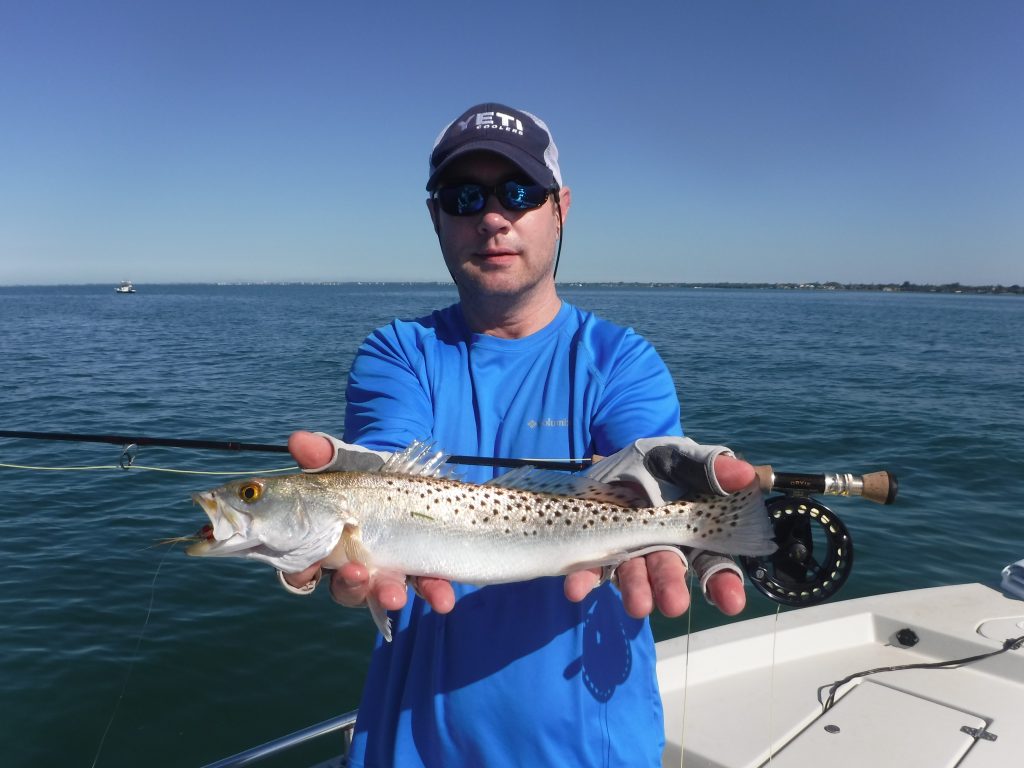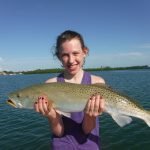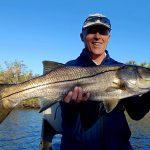Fly Fishing for spotted sea trout
This section covers fly fishing for spotted sea trout in Florida. Anglers have the opportunity to catch many different species in Sarasota Bay in the inshore Gulf of Mexico.
Fly fishing is enjoyed by many anglers visiting Florida. Any fish species that can be caught on and artificial lure will take a well presented fly. Most anglers can learn to cast well enough to catch a fish with just a few hours of practice. The following information is geared to the novice angler that is interested in getting into the sport of fly fishing.
read more about how to catch speckled trout
The primary difference between fly fishing and spin fishing is that and fly fishing the line provides the wait for casting. With spin fishing, it is the other way around. Realizing this will help take some of the mystery out of fly fishing. It really is not that difficult to learn. However, as in all fishing, proper equipment is important.
Fly fishing tackle
The three major components of a fly fishing outfit are the rod, line, and reel. Believe it or not, the real is the least important of the three. It basically holds the line and provides drag on a larger fish. The vast majority of time, the line will be manipulated with the anglers hand.
Fly tackle is designated by “weight”, shown as”Wt” on rods. A 6wt rod is then matched to a 6wt line along with a corresponding reel. Not to over complicate, but rods also come in various actions and lines come in several different forms. The easiest rod for most anglers starting out fly fishing is a “mid flex” rod. This is the most forgiving action and the easiest to learn how to cast.
Fly lines come in floating, sink tip, and full sinking varieties. Floating lines are the easiest to use while full sinking lines are the most difficult. In between is the sink tip line, which is the most versatile all round fly line for most anglers fly fishing Florida.
7 wt outfits are a great choice for fly anglers
So, the best all around fly fishing outfit for someone new to the sport would be a 7wt rod with a medium or mid flex action, a 7wt intermediate sink tip line, and a matching reel. Fly lines are usually around 100 feet long. On the real underneath the fly line is a couple hundred yards of “backing”. This adds volume to the spool and also gives the angler extra for line if a large fish makes a long run.
A leader is used between the end of the fly line in the fly. These leaders are generally tapered. This means they are thicker at the fly line and then they are at the fly and. This allows for easier casting and better presentation as the fly rolls out smoother. Most anglers use a short “bite tippet”. This is the same as the shock leader that almost all spin fisherman use. Leaders can be hand-tied, but most anglers purchase commercially prepared leaders.
Effective spotted sea trout fly patterns
Just as with artificial lures, there are countless fly patterns, colors, and sizes. However, anglers only need a couple different patterns in several colors to consistently catch fish in Florida. As with all fishing, the idea is to match the fly to the size and type of forage that the fish are feeding on. However, large bulky flies are difficult to cast, especially for the beginner.
The Clouser Minnow is arguably the most popular saltwater fly, and for good reason. It consists of dumbbell eyes which provide weight and give the fly action along with some buck tail or synthetic care dressing. The weight of the eyes gives it a jigging action in the water. The hairdressing can mimic most bait fish and crustaceans.
The Crystal Shrimp is another very effective fly. It is deadly for snook both out on the beach and went fishing the lighted docks and bridges at night. It also works very well on the beaches for false albacore as well as over the deeper grass flats for speckled trout and other species.
The D.T Special is the third of the “must-have” flies that anglers fly fishing Florida use. It is unweighted and is a terrific bait fish imitator. This fly works very well for anglers fly fishing off the beach and is deadly in the inshore Gulf of Mexico for Spanish mackerel and false albacore. It also works very well anytime breaking fish are seen feeding on the surface, such as bluefish and ladyfish.
Fly casting for spotted sea trout
Fly casting is a skill, and some even call it an art. It really is not that difficult, once the basics are mastered. Wind is an issue when trying to fly fish. Even the most experienced fly anglers have trouble on breezy days. It is probably best for novice fly anglers to give it a try on days when the wind is calm.
There are many good resources that anglers can access to learn how to fly cast. So, I will not try to duplicate them here. YouTube videos are a great source. Anglers who choose to invest a few dollars in a fly casting and fly fishing course will find that a great investment. Do not wait to get out on the boat before trying to learn to cast! This will only lead to frustration and disappointment. Orvis offers classes throughout Florida.
Finally, it is time to go fishing! We have our seven weight rod, intermediate sink tip line, 9 foot tapered leader, and a #1 white and chartreuse Clouser tied on the end. We have practiced casting and can throw 40 feet to 50 feet of line. The best place to to catch fish on the fly for the novice angler are the deep grass flats.
Fly fishing the deep grass flats
Florida has many many acres of submerge grass beds and 3 feet of water to 10 feet of water. These flats hold just about every inshore saltwater species. This is where I fish on my Sarasota fishing charters for clients that are looking for action and variety. It is fairly easy fishing and does not require great fly casting skill. Speckled trout, bluefish, ladyfish and more provide great action.
The technique is quite simple. Anglers set up a drift where the wind and current will push the boat over the area to be finished. Fly anglers will do well to target water depth of 4 feet deep to 8 feet deep. It can be difficult to get a fly much deeper than that on a drifting boat.
Anglers want the wind to be over their casting shoulder. The vast majority of people are right-handed. Therefore, placing the angler on the bow the boat with the breeze over his or her right shoulder works the best. Obviously, the situation is reversed for a left handed caster.
As the boat drifts across, the fly line is cast out. The fly and line are then allowed to settle for several seconds. With the rod tip low to the water, the angler retrieves the fly back with the off hand. Again, a right-handed angler will have the rod in his or her right hand and will strip the line back in with the left hand. Once most of the fly line is retrieved, it will be cast out again in the process repeated.
Hooking fish on the fly
It is easy to tell when a fish takes the fly. The fly line really transmits the bite. When an angler gets bit, he or she pulls sharply with the stripping hand removing all the slack then the rod tip is raised up. This is called the “strip set”and is used in most saltwater fishing and even in freshwater fishing when using streamers.
Smaller fish are then brought in by hand stripping the line in. Larger fish may make a run taking up all the slack and getting on the reel. Once this occurs, the fish is then fought using the reel. Keep in mind that fly fishing reels are “single action”. This means that the real handle will go forward and backward, so keep your knuckles clear when a big fish makes it run.
In conclusion, this article on spotted sea trout fishing should help anglers catch more of these desirable and popular inshore saltwater fish!







